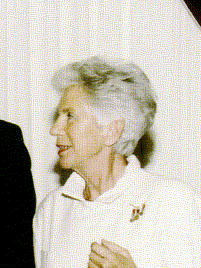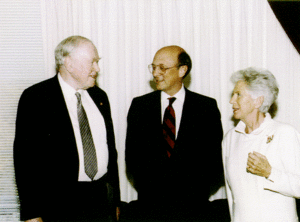Jeannie Rousseau facts for kids
Quick facts for kids
Jeannie Rousseau
|
|
|---|---|

Jeannie Rousseau
|
|
| Born | 1 April 1919 |
| Died | 23 August 2017 (aged 98) Montaigu, France
|
| Spouse(s) | Henri de Clarens |
Jeannie Yvonne Ghislaine Rousseau, later known as Jeannie de Clarens, was a brave secret agent for the Allies during World War II. She was born on April 1, 1919, and passed away on August 23, 2017. Jeannie was part of a secret group called the "Druids" network, led by Georges Lamarque.
Her secret code name was Amniarix. She was very good at avoiding the German secret police (the Gestapo) while gathering important information. She found out about Germany's new rocket weapons programs from behind enemy lines. Her secret reports were sent to London. These reports helped the British plan a big attack on Peenemünde. They also caused delays and problems for Germany's V-1 and V-2 rocket plans. This saved many thousands of lives in Western countries. Jeannie was caught twice and held in three different concentration camps. After the war, she worked as a translator.
Contents
Jeannie's Early Life
Jeannie Yvonne Ghislaine Rousseau was born on April 1, 1919, in Saint-Brieuc, France. Her father, Jean Rousseau, was a veteran from World War I and worked for the French government. Her mother was Marie Le Charpentier.
Jeannie was very good at languages. She finished her language studies at a special school called Sciences Po in 1939. When World War II started, she moved with her family to Dinard. The mayor of Dinard, who was a friend of her parents, asked her to work as a translator. Her job was to help local French people talk to the German soldiers who were in charge.
Working as a Secret Agent
Jeannie started gathering information about German operations even before she officially joined the Allied secret service. She got a job as a translator at the French national chamber of commerce. Soon, she became the top person there. This meant she met regularly with the German military commander's staff.
She often visited the Germans to talk about business issues. For example, she would discuss complaints about the Nazis taking things or offer to sell them goods like steel and rubber. She later said, "I was storing my nuts, but I had no way to pass them on." In January 1941, the Gestapo arrested her. But they let her go because they didn't have enough proof. She had to leave the area and was not allowed to stay near the coast.
In 1941, she moved to Paris. There, she started working for a company that supplied materials to the German war effort. This job put her in a perfect position to find valuable information for the Allies.
Her official work as a spy began in 1941. She met Georges Lamarque by chance on a night train from Paris. Lamarque remembered Jeannie from the University of Paris. She had been excellent at languages, including German, and finished first in her class in 1939. He asked her to work for him, and she quickly agreed.
Important Reports on Rocket Programs
In 1943, Jeannie sent two very important reports about Peenemünde. These reports helped R.V. Jones, a British intelligence officer, and the rest of the British government understand that Germany was developing missiles and rockets there. Jeannie gathered and sent this information under very difficult conditions. Her reports, combined with Jones's analysis, led to British air raids on Peenemünde.
Some sources incorrectly say that Jeannie's report led to the big raid on Peenemünde on August 17/18, 1943. However, her report did not reach R.V. Jones until after that date. These stories also wrongly suggest her main contribution was about the V-2 rocket. But she was connected to Max Wachtel's V-1 group. It was her report that first showed where Wachtel was testing the V-1 rocket, at a nearby place called Zempin. This site was not hit in the August 17th/18th raid. The Allies already knew about the V-2s and Peenemünde before her first report.
R.V. Jones later said that when he first asked about the source of the amazing report that warned the British about Peenemünde, he only learned it came from "one of the most remarkable young women of her generation." She was part of a small spy network working in German-controlled France.
Capture and Imprisonment
Just before D-Day (the big Allied invasion), a plan to get Jeannie and two other agents out of France was stopped by the Gestapo. She was arrested on April 28, 1944, in La Roche-Derrien. She was the first to be caught, but even as she was being captured, she warned her friends, and one of them escaped.
First, she was held and questioned at Jacques Cartier prison in Rennes. Then, in August 1944, she was sent from Pantin to Ravensbrück, a concentration camp. From there, she was sent to the Torgau labor camp. At Torgau, she bravely organized a protest against using prisoners to make ammunition.
R.V. Jones said that Jeannie's reports are a brilliant part of intelligence history. He added that three concentration camps—Ravensbrück, Königsberg (a punishment camp), and Torgau—could not break her spirit. The Swedish Red Cross rescued her shortly before the war ended.
Life After the War

While recovering in Sweden from a lung illness (tuberculosis) she got during her time in prison, Jeannie met Henri de Clarens. Henri had also been held in the Buchenwald and Auschwitz concentration camps. They got married and had two children. Henri de Clarens passed away in 1995.
After the war, Jeannie worked as a freelance translator for the United Nations and other groups. She usually avoided talking to reporters and historians, so her story was not widely known for a long time. In 1993, as Madame Jeannie de Clarens, she agreed to accept the Central Intelligence Agency's Agency Seal Medal. She shared more details of her story with journalist David Ignatius in 1998.
She received many other awards for her bravery. These included the Legion of Honour in 1955, and a higher medal (the grand officer medal) in 2009. She also received the Resistance Medal and the Croix de guerre.
Jeannie Rousseau passed away on August 23, 2017, in Montaigu, Vendée, at the age of 98.
See also
- V-1 and V-2 Intelligence

